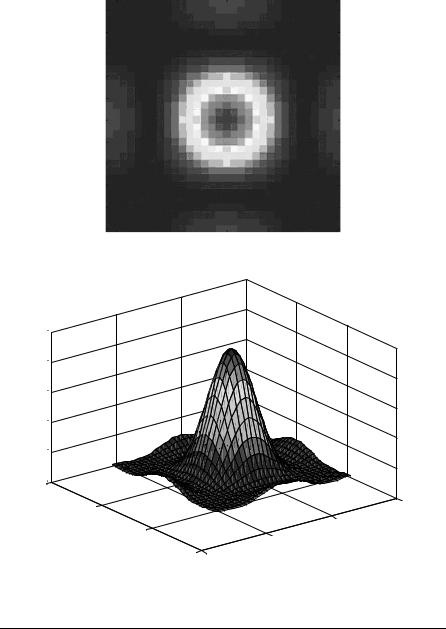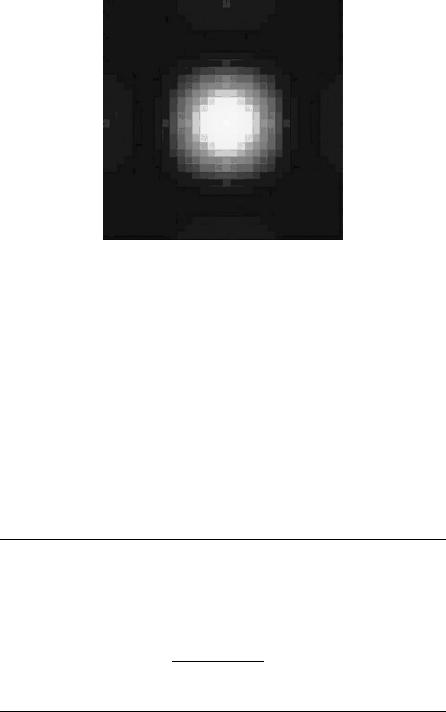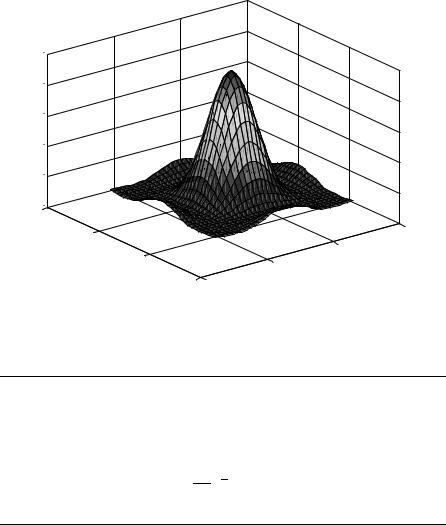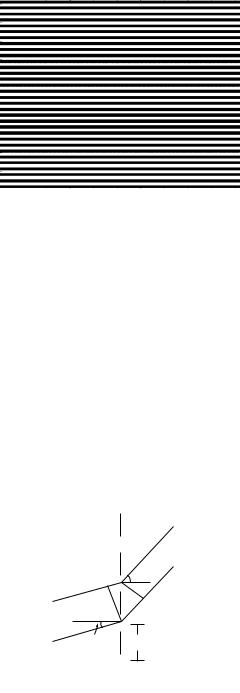
Ersoy O.K. Diffraction, Fourier optics, and imaging (Wiley, 2006)(ISBN 0471238163)(427s) PEo
.pdf
68 |
|
|
FRESNEL AND FRAUNHOFER APPROXIMATIONS |
|||||||||||||
where xb and xe are given by |
|
r |
|
|
|
|
|
|
|
|
|
|
||||
|
|
|
D |
|
|
|
|
|||||||||
|
|
|
|
2 |
|
|
|
|
|
|
|
|||||
xb ¼ |
|
|
|
|
|
|
|
þ x0 |
|
|
||||||
lz |
2 |
|
|
|||||||||||||
|
|
|
r |
|
|
|
|
|
|
|
|
|
|
|||
xe ¼ |
2 |
|
D |
þ x0 |
|
|
|
|||||||||
lz 2 |
|
|
|
|||||||||||||
Eq. (5.2-15) can be written as |
|
|
|
|
|
|
|
|
|
|
|
|
|
|
|
|
1 |
xe |
|
|
|
|
1 |
|
|
xb |
|
|
|||||
|
p 2 |
|
|
p 2 |
ð5:2-17Þ |
|||||||||||
Ix ¼ p2 |
ð ej2v |
dv p2 |
ð ej2v |
dv |
||||||||||||
|
|
0 |
|
|
|
|
|
|
|
|
|
0 |
|
|
||
The Fresnel integrals C(z) and S(z) are defined by |
|
|
||||||||||||||
|
|
|
z |
|
|
|
|
|
|
|
v2 |
|
|
|
|
|
|
|
|
|
|
|
|
|
|
|
|
|
|
|
|
||
CðzÞ ¼ ð0 |
cos |
p |
|
dv |
|
ð5:2-18Þ |
||||||||||
2 |
|
|
||||||||||||||
|
|
|
z |
|
|
|
|
|
|
|
v2 |
|
|
|
|
|
|
|
|
|
|
|
|
|
|
|
|
|
|
|
|
|
|
|
SðzÞ ¼ ð0 |
sin |
p |
dv |
|
ð5:2-19Þ |
||||||||||
|
2 |
|
||||||||||||||
In terms of C(z) and S(z), Eq. (5.2-17) is written as |
|
|
||||||||||||||
1 |
|
|
|
|
|
|
|
|
|
|
|
|
|
|
|
ð5:2-20Þ |
|
|
|
|
|
|
|
|
|
|
|
|
|
|
|
||
Ix ¼ p2 f½CðxeÞ CðxbÞ& þ j½SðxeÞ SðxbÞ&g |
||||||||||||||||
The integral above also occurs with respect to y in Eq. (5.2-15). Let it be denoted by Iy, which can be written as
|
|
ye |
|
|
|
|
|
|
|
|
|
1 |
p 2 |
|
|
|
|
|
|
|
|
|
|
Iy ¼ |
p2 |
ð ej2v dv |
|
|
|
|
|
|
|
|
|
|
1 |
yb |
|
|
|
|
|
|
|
|
ð5:2-21Þ |
|
|
|
|
|
|
|
|
|
|
|
|
¼ p2 f½Cðye CðybÞ& þ j½Sðye SðybÞ&g |
|||||||||||
where |
|
r |
|
|
|
||||||
|
|
|
D |
||||||||
|
|
yb ¼ |
2 |
|
|
þ y0 |
|||||
|
|
|
|
|
|
|
|
|
|
||
|
|
|
|
lz |
2 |
|
|||||
|
|
r |
D |
|
|
|
|||||
|
|
Ye ¼ |
|
2 |
|
|
y0 |
||||
|
|
lz |
2 |
||||||||

DIFFRACTION IN THE FRESNEL REGION |
69 |
Equation (5.2-15) for Uðx0; y0; zÞ can now be written as
|
|
|
|
ejkz |
|
|||
|
|
|
Uðx0; y0; zÞ ¼ |
|
|
jxjy |
ð5:2-22Þ |
|
|
2j |
|||||||
The intensity Iðx0; y0; zÞ ¼ jUðx0; y0; zÞj2 can be written as |
|
|||||||
Iðx0; y0; zÞ ¼ |
1 |
f½CðxeÞ CðxbÞ&2 þ ½SðxeÞ SðxbÞ&2g |
|
|||||
|
|
|
||||||
|
4 |
|
||||||
|
f½CðyeÞ CðybÞ&2 þ ½SðyeÞ SðybÞ&2g |
ð5:2-23Þ |
||||||
The Fresnel number NF is defined by |
|
|||||||
|
|
|
NF ¼ |
D2 |
ð5:2-24Þ |
|||
|
|
|
4lz |
|
||||
For constant D and l, NF decreases as z increases.
The Fresnel diffraction intensity from a square aperture is visualized in Figures 5.2–5.5. As z gets less, the intensity starts resembling the shape of the input square aperture. This is further justified in Example 5.5. Figure 5.2 shows the image of the square aperture used. Figure 5.3 is the Fresnel intensity diffraction pattern from the square aperture. Figure 5.4 is the same intensity diffraction pattern as a 3-D plot.
Figure 5.2. The input square aperture for diffraction studies.

70 |
FRESNEL AND FRAUNHOFER APPROXIMATIONS |
Figure 5.3. The intensity diffraction pattern from a square aperture in the Fresnel region.
100 
80 
60 
40 
20 
0 
0.5
0 |
0.5 |
|
|
|
0 |
–0.5
–0.5
–1 –1
Figure 5.4. The same intensity diffraction pattern from the square aperture in the Fresnel region as a 3-D plot.
EXAMPLE 5.5 Using the Fresnel approximation, show that the intensity of the diffracted beam from a rectangular aperture looks like the rectangular aperture for small z.
Solution: The intensity pattern from the rectangular aperture is given by Eq. (5.2-22) where Dx and Dy are used instead of D along the x- and y-directions, respectively.

DIFFRACTION IN THE FRESNEL REGION |
|
|
|
|
|
|
|
71 |
||||||
The variables for very small z can be written as |
|
|
|
|
|
|||||||||
|
r |
|
|
|
|
1 |
|
|
|
|
|
|||
|
2 |
|
D |
! ( |
|
|
x0 > Dx=2 |
|||||||
xb ¼ |
|
|
lz |
|
2 |
þ x0 |
1x0 < Dx=2 |
|||||||
r |
|
1 |
|
< Dx=2 |
||||||||||
|
|
2 D |
|
|
|
|
x0 |
|||||||
xe ¼ |
|
lz 2 |
x0 |
! ( 1 x0 > Dx=2 |
||||||||||
|
r |
|
|
|
|
1 |
|
|
|
|
|
|||
|
|
|
2 D |
! ( |
1 y0 > Dy=2 |
|||||||||
yb ¼ |
|
|
lz |
|
2 |
þ y0 |
|
y0 < Dy=2 |
||||||
r |
|
1 |
|
< Dy=2 |
||||||||||
|
|
2 |
D |
|
|
|
|
y0 |
||||||
ye ¼ |
|
lz |
|
2 |
y0 |
! ( 1 y0 > Dy=2 |
||||||||
The asymptotic limits of cosine and sine integrals are given by |
||||||||||||||
Cð1Þ ¼ Sð1Þ ¼ 0:5; Cð 1Þ ¼ Sð 1Þ ¼ 0:5 |
||||||||||||||
Consequently, Eq. (5.2-22) becomes |
|
|
|
|
|
|
|
|
||||||
|
|
|
|
|
|
|
x0 |
rect |
y0 |
|
|
|||
|
|
Iðx0; y0; zÞ ’ rect |
|
|
|
|
||||||||
|
|
D |
|
D |
|
|||||||||
for small z.
EXAMPLE 5.6 Show under what conditions the angular spectrum method reduces to the Fresnel approximation.
Solution: The transfer function in the angular spectrum method is given by
|
|
|
( |
p |
q |
HA |
ð |
fx; fy |
Þ ¼ |
ejz k2 4p2ðfx2þfy2Þ |
fx2 þ fy2 < l1 |
|
|
0 |
otherwise |
The transfer function in the Fresnel approximation is given by
HFðfx; fyÞ ¼ ejkze jplzðfx2þfy2Þ
If
q |
4p2ð fx2 þ fy2Þ |
|||||
|
2 |
2 |
2 |
2 |
|
|
k |
|
4p |
ð fx |
þ fy |
Þ k |
2k |
that corresponds to keeping the first two terms of the Taylor expansion HAð fx; fyÞ equals HFð fx; fyÞ. The approximation above is valid when jlfxj, jlfyj 1. In conclusion, the Fresnel approximation and the angular spectrum method are approximately equivalent for small angles of diffraction.
72 |
FRESNEL AND FRAUNHOFER APPROXIMATIONS |
5.3FFT IMPLEMENTATION OF FRESNEL DIFFRACTION
Fresnel diffraction can be implemented either as convolution given by Eq. (5.2-10) or by directly using the DFT after discretizing Eq. (5.2-13). The convolution implementation is similar to the implementation of the method of the angular spectrum of plane waves. The second approach is discussed below.
Let Uðm1; m2; 0Þ ¼ Uð xm1; ym2; 0Þ be the discretized u(x,y,0). Thus, x and y are discretized as xm1 and xm2, respectively. Similarly, x0 and y0 are discretized as x0n1 and x0n2, respectively. We write
U0ðm1; m2; 0Þ ¼ Uðm1; m2; 0Þej |
k |
½ð xm1Þ2þð ym2Þ2& |
ð5:3-1Þ |
2z |
In order to use the FFT, the Fourier kernel in Eq. (5.2-13) must be expressed as
e j2lpzðx0xþy0yÞ ¼ e j2lpzð x x0n1m1þ y y0n2m2Þ ¼ e j2p |
n m |
1 |
|
n m |
2 |
|
|
||||||||
1 |
|
þ |
2 |
ð5:3-2Þ |
|||||||||||
N1 |
|
N2 |
|
||||||||||||
where N1 N2 is the size of the FFT to be used. Hence, |
|
|
|
|
|
|
|||||||||
|
2p |
2p |
|
|
n1m1 |
|
|
|
|
|
|
||||
|
|
x0x ¼ |
|
x x0n1m1 ¼ 2p |
|
|
|
|
|
|
|
|
|||
|
lz |
lz |
N1 |
|
|
|
|
|
|
||||||
This yields |
|
|
|
|
|
|
|
|
|
|
|
|
|
||
|
|
|
x x0 ¼ |
lz |
|
|
|
|
|
|
|
|
|
ð5:3-3Þ |
|
|
|
|
N1 |
|
|
|
|
|
|
|
|
||||
Similarly, we have |
|
|
|
|
|
|
|
|
|
|
|
|
|
||
|
|
|
y y0 ¼ |
lz |
|
|
|
|
|
|
|
|
|
ð5:3-4Þ |
|
|
|
|
N2 |
|
|
|
|
|
|
|
|
||||
In other words, small x or y gives large x0 or y0 and vice versa, respectively. Equations (5.3-3) and (5.3-4) can be compared to Eq. (4.4-12) for the angular spectrum method. For fx ¼ x0=lz and fy ¼ y0=lz, these equations are the same. However, now the output is directly given by Eq. (5.2-3), there is no inverse transform to be computed, and hence the input and output windows can be of different sizes.
|
ð |
|
|
Þ |
|
2 |
2 |
|
|
In order to use the FFT, U0 |
|
m1 |
; m2; 0 |
|
is shifted by |
N1 |
; |
N2 |
, as discussed |
previously in Section 4.4. Suppose the result is U00ðm1; m2; 0Þ. |
|
|
|
||||||
The discretized output wave Uðn1; n2; zÞ ¼ Uð x0n1; y0n2; zÞ is expressed as
|
ejkz |
|
k |
2 |
2 |
|
X X |
n1m1 |
|
n2m2 |
|
|||||||||
|
|
|
N1 |
1 |
N2 |
1 |
|
|
||||||||||||
Uðn1; n2; zÞ ¼ |
jlz |
ej |
2z |
½ð x0n1 |
Þ |
þð y0n2Þ |
& x y m1 |
¼ |
0 |
m2 |
¼ |
0 U00ðm1; m2; 0Þe j2p |
N1 |
þ |
N2 |
|
||||
|
|
|
|
|
|
|
|
|
|
|
|
|
|
|
|
|
|
|
||
|
|
|
|
|
|
|
|
|
|
|
|
|
|
|
|
|
ð5:3-5Þ |
|||
Uðn1; n2; zÞ is shifted again by |
N1 |
; |
N2 |
in order to correspond to the real wave. |
|
|||||||||||||||
2 |
2 |
|
||||||||||||||||||

PARAXIAL WAVE EQUATION |
73 |
EXAMPLE 5.7 Consider Example 4.4. With the same definitions used in that example, the pseudo program for Fresnel diffraction can be written as
u1 ¼ u exp j k ðx2 þ y2Þ
2z u1p ¼fftshiftðu1Þ
ejkz
u3 ¼ jlz ej2kzðx20þy20Þ u2
U¼fftshiftðu3Þ
5.4PARAXIAL WAVE EQUATION
The Fresnel approximation is actually a solution of the paraxial wave equation derived below. Consider the Helmholtz equation . If the field is assumed to be propagating mainly along the z-direction, it can be expressed as
Uðx; y; zÞ ¼ U0ðx; y; zÞejkz |
ð5:4-1Þ |
where U0ðx; y; zÞ is assumed to be a slowly varying function of z. Substituting Eq. (5.4-1) in the Helmholtz equation yields
r2U0 |
d |
ð5:4-2Þ |
þ 2jk dz U0 ¼ 0 |
As U0ðx; y; zÞ is a slowly varying function of z, Eq. (5.4-2) can be approximated as
d2U0 þ d2U0 þ 2jk d U0 ¼ 0 dx2 dy2 dz
Equation (5.4-3) is called the paraxial wave equation. Consider
1 jkðx2þy2Þ
U1ðx; yÞ ¼ jlz e 2z
ð5:4-3Þ
ð5:4-4Þ
It is easy to show that U1 is a solution of Eq. (5.4-3). As Eq. (5.4-3) is linear and shift invariant, U1ðx x1; y y1Þ for arbitrary x1 and y1 is also a solution. Superimposing

74 FRESNEL AND FRAUNHOFER APPROXIMATIONS
such solutions, a general solution is found as |
|
|
|
|
|
|
|
|
|
|
|
|
|
|
|
|||
Uðx; y; zÞ ¼ jlz ðð gðx1; y1Þe |
|
ðð |
|
|
|
Þ |
2z |
|
Þ2 |
|
dx1dy1 |
ð5:4-5Þ |
||||||
|
1 |
|
|
jk |
x |
|
x1 |
|
2þðy y1 |
Þ |
|
|
|
|
||||
Consider the Fresnel approximation given by |
|
|
|
|
|
|
|
|
|
|
|
|
|
|
|
|||
Uðx0; y0; zÞ ¼ jlz ðð Uðx; y; 0Þe |
ðð |
|
|
|
Þ |
2z |
|
|
|
|
dxdy |
ð5:4-6Þ |
||||||
1 |
|
|
|
jk |
|
x0 |
x |
2þðy0 yÞ2 |
Þ |
|
|
|||||||
Choosing gðx; yÞ ¼ Uðx; y; 0Þ, it is observed that Eqs. (5.4-5) and (5.4-6) are the same. Hence, the Fresnel approximation is a solution of the paraxial wave equation.
5.5DIFFRACTION IN THE FRAUNHOFER REGION
Consider Eq. (5.2-14). If |
|
|
|
|
|
|
|
|
|
|
k |
ðx2 þ y2Þmax |
|
kL2 |
|
|
|
z |
|
|
¼ |
|
1 |
; |
ð5:5-1Þ |
|
2 |
2 |
|||||||
then, U0ðx; y; 0Þ is approximately equal to U(x,y,0). When this happens, the Fraunhofer region is valid, and Eq. (5.2-13) becomes
Uðx0; y0 |
; zÞ ¼ jlz ej2zðx0 |
þy0Þ |
ðð |
Uðx; y; 0Þe jlzðx0xþy0yÞdxdy |
ð5:5-2Þ |
||||||
|
ejkz |
|
k 2 |
2 |
1 |
|
2p |
|
|||
|
|
|
|
|
|
|
1 |
|
|
|
|
Aside from multiplicative amplitude and phase factors, Uðx0; y0; zÞ is observed to be the 2-D Fourier transform of U(x,y,0) at frequencies fx ¼ x0=lz and fy ¼ y0=lz. It is also observed that diffraction in the Fraunhofer region does not have the form of a convolution.
EXAMPLE 5.8 Find the wave field in the Fraunhofer region due to a wave emanating from a circular aperture of diameter D at z ¼ 0.
Solution: The circular aperture of diameter D means
Uðx; y; 0Þ ¼ cylðr=DÞ
p where r ¼ x2 þ y2.
From Example 2.6, the 2-D Fourier transform of U(x,y,0) is given by
|
D2p |
q |
|
Uðx; y; 0Þ $ |
4 |
|
somb D fx2 þ fy2 |

DIFFRACTION IN THE FRAUNHOFER REGION |
75 |
Figure 5.5. The intensity diffraction pattern from a square aperture in the Fraunhofer region.
where fx ¼ x0=lz and fy ¼ y0=lz. Using Eq. (5.5-2) gives |
|
||||||||||||||
ð |
Þ ¼ |
|
l |
|
|
|
|
|
|
2 |
|
q |
2 |
||
|
|
e |
jkz |
2 |
|
|
|
||||||||
|
|
|
|
|
k 2 |
|
D p |
|
|
|
|||||
U x0; y0; z |
|
j |
|
|
z |
ej |
2z |
ðx0 |
þy0 |
Þ |
|
4 |
somb D |
fx2 þ fy2 |
|
The intensity distribution equal to U2ðx0; y0; zÞ is known as the Airy pattern. It is
given by |
|
|
|
h |
q i |
|
|
Iðx0; y0; zÞ ¼ |
kD2 |
|
2 |
2 |
|||
|
|
||||||
|
somb |
D fx2 þ fy2 |
|||||
8z |
|
|
The Fraunhofer diffraction intensity from the same square aperture of Figures 5.2 is visualized in Figures 5.5 and 5.6. Figure 5.5 is the Fraunhofer intensity diffraction pattern from the square aperture. Figure 5.6 is the same intensity diffraction pattern as a 3-D plot.
EXAMPLE 5.9 Determine when the Fraunhofer region is valid if the wavelength is 0.6 m (red light) and an aperture width of 2.5 cm is used.
Solution:
z |
kL12 |
|
pL12 |
|
|
|||||
|
|
¼ |
|
|
|
|
|
|||
2 |
|
|
l |
|
|
|||||
|
pL12 |
|
¼ |
p ð1:25 10 2Þ2 |
¼ |
830 m |
||||
|
l |
|
||||||||
|
|
|
0:6 10 6 |
|
||||||
This large distance will be much reduced when the lenses are discussed in Chapter 8.

76 |
FRESNEL AND FRAUNHOFER APPROXIMATIONS |
100 
80 
60 
40 
20 
0 
0.5
0 |
0.5 |
|
0 |
||
|
–0.5
–0.5
–1 –1
Figure 5.6. The same intensity diffraction pattern from the square aperture in the Fraunhofer region as a 3-D plot.
EXAMPLE 5.10 Consider Example 5.7. With the same definitions used in that example, the pseudo program for Fresnel diffraction can be written as
u1 ¼ fftshiftðu1Þ u2 ¼ fftðu1Þ
ejkz
u3 ¼ jlz ej2kzðx20þy20Þ u2
U¼ fftshiftðu3Þ
5.6DIFFRACTION GRATINGS
Diffraction gratings are often analyzed and synthesized by using Fresnel and Fraunhofer approximations. Some major application areas for diffraction gratings are spectroscopy, spectroscopic imaging, optical communications, and networking.
A diffraction grating is an optical device that periodically modulates the amplitude or the phase of an incident wave. Both the amplitude and the phase may also be modulated. An array of alternating opaque and transparent regions is called a transmission amplitude grating. Such a grating is shown in Figures 5.7 and 5.8.

DIFFRACTION GRATINGS |
77 |
Figure 5.7. Planar view of a transmission amplitude grating.
If the entire grating is transparent, but varies periodically in optical thickness, it is called a transmission phase grating. A reflective material with periodic surface relief also produces distinct phase relationships upon reflection of a wave. These are known as reflection phase gratings. Reflecting diffraction gratings can also be generated by fabricating periodically ruled thin films of aluminum evaporated on a glass substrate.
Diffraction gratings are very effective to separate a wave into different wavelengths with high resolution. In the simplest case, a grating can be considered as a large number of parallel, closely spaced slits. Regardless of the number of slits, the peak intensity occurs at diffraction angles governed by the following grating equation:
d sin fm ¼ ml |
ð5:6-1Þ |
where d is the spacing between the slits, m is an integer called diffraction order, and f is the diffraction angle. Equation (5.6-1) shows that waves at different
mth order
qm
qi d
Figure 5.8. Periodic amplitude grating.
